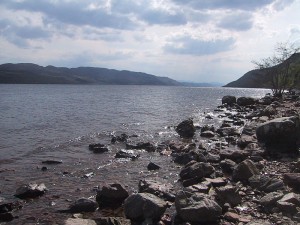Reflections on the Loch Ness Monster
Posted by: Ken Gerhard on April 26th, 2013

For my first ever Cryptomundo post, I thought it would be fitting to reflect on the Loch Ness mystery for a couple of reasons. First off, it was at age fifteen (back in 1982) that I wandered the shores of the mist-shrouded loch, armed with my little super 8 movie camera in hopes of, capturing footage of a monster. As it turned out, that particular enterprise became an influential event in my life.
But more importantly, this month marks the 80th anniversary of the first notable sighting – that of hotel owners John and Aldie Mackay who, watched a monster-sized fish thrash around on the lake’s surface for several minutes during April 14th, 1933. Moreover, the month of April seems to bear a great deal of significance with regard to Scotland’s grand cryptozoological enigma. For example, it was during April of 1934 that the famous surgeon’s photo, taken by Dr. Robert Kenneth Wilson was allegedly taken, though that famous, tantalizing image has since been exposed as a clever hoax.
Yet, perhaps the most important piece of evidence is 500 feet of 16 millimeter film that was shot by aeronautical engineer Tim Dinsdale on April 23rd, 1960.
Despite the fact that, like most photographic evidence of a cryptozoological nature, it remains controversial after all of these years, in my mind it stands as the single most compelling argument that some massive animal dwells in the lake. The footage has been scrutinized by many, including England’s JARIC intelligence division who, concluded that it showed a large, animate object of unknown nature swimming about. Skeptics have argued that the distant object was merely a boat, but there appears to be a shadowy body trailing beneath the surface that would suggest otherwise.
Seemingly, the vast majority of Nessie photos strike me as being fishy (no pun intended), including the highly publicized underwater images taken in the mid 1970s by Robert Rines and his Academy of Applied Science. However, can we really dismiss hundreds of eyewitness reports that have been logged through the years? Surely not every one can be discounted as merely a tall tale or misidentification of a boat wake. And how about the handful of sonar images that have been documented, showing a large mass swimming around that is much larger than any native species? Loch Ness is certainly very deep with poor visibility and an adequate food supply. And descriptions of the monster coincide very well with other lake monsters around the word, as well as the Great Sea Serpents that have been logged for centuries.
Most Cryptomundo readers are savvy enough to be familiar with the prevalent theories. Several eminent investigators including Richard Freeman, feel that Nessie may be a fifteen-foot eel. Others have suggested a relict from the past such as a surviving plesiosaur or snakelike whale (zeuglodon). Roy Mackal proposed a monstrous amphibian and Ted Holiday favored a gargantuan sea slug.
For my money, the best explanation for the Loch Ness Monster may be a case of composite identity. Perhaps there truly are some outsized eels dwelling near the bottom that surface on rare occasions, creating a stir. There is also a strong possibility that large marine animals such as seals and whales have made their way into the loch throughout the years. Media hype, misidentifications and overzealous hotel owners surely have played a part in propagating the legend. However, it is worth noting that Nessie sightings have diminished greatly in recent years, despite the increased presence of tourists and researchers around the loch.
Ultimately we may have to wait another 80 years for definitive answers, as the ancient waters of Loch Ness remain so very cold, dark and deep…
About Ken Gerhard
Ken has investigated reports of mysterious beasts around the world including Bigfoot, the Loch Ness Monster, the Chupacabra, giant winged creatures and even werewolves. In addition to appearing in three episodes of the television series Monster Quest (History Channel), Ken is featured in the History Channel special The Real Wolfman, as well as Legend Hunters (Travel Channel/A&E), Paranatural (National Geographic), Ultimate Encounters (truTV) and William Shatner's Weird or What? (History Television). His credits include multiple appearances on Coast to Coast AM, major news broadcasts and Ireland’s Newstalk radio, as well as being featured in major books and in articles by the Associated Press, Houston Chronicle and Tampa Tribune. Ken is author of the books Big Bird: Modern Sightings of Flying Monsters and A Menagerie of Mysterious Beasts: Encounters with Cryptid Creatures, as well as the co-author of Monsters of Texas (with Nick Redfern) and has contributed to trade publications including Fate Magazine, Animals and Men, The Journal of the British Columbia Scientific Cryptozoology Club and Bigfoot Times. He currently lectures and exhibits at events across America. Born on Friday the 13th of October, 1967 (exactly one week before the famous Patterson Bigfoot film was shot), Ken has traveled to twenty-six different countries on six continents and most of the United States. An avid adventurer, he has camped along the Amazon, explored the Galapagos, hiked the Australian Outback and has visited many ancient and mysterious sites, from Machu Pichu to Stonehenge.










Enjoyed your first ever Cryptomundo post. Looking forward to seeing more from you!
Ken, nicely done.
Not sure how any type of air-breathing creature could remain hidden in the Loch for long; due to their obligatory need to surface for air. Some type of large eel or amphibian would seem to be a more likely candidate – but I didn’t come here to argue over minutia…
As a mere sometime-commenter I have nothing but respect for individuals such as yourself who are willing to take the time and make the effort to compose a full-fledged Post.
Again, kudos! I wish you continued success and hope this is but the first of many more Posts to come.